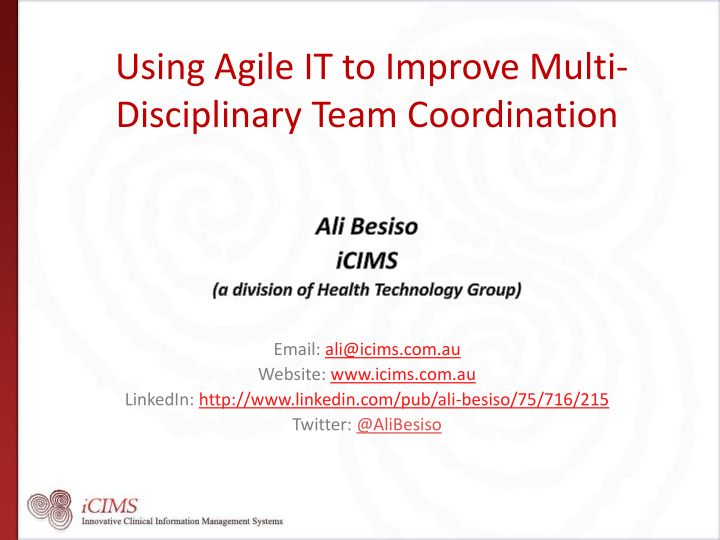



Using Agile IT to Improve Multi- Disciplinary Team Coordination Email: ali@icims.com.au Website: www.icims.com.au LinkedIn: http://www.linkedin.com/pub/ali-besiso/75/716/215 Twitter: @AliBesiso
Presentation Overview 1. MDM Overview & Models 2. Case Studies 3. Research 4. Outcomes 5. Lessons Learned
MDM Overview & Models
What are MDMs Multi-Disciplinary Care “Multidisciplinary care is a collaborative approach to treatment planning and ongoing care throughout the treatment pathway” Multi-Disciplinary Meetings (MDM) “aims to ensure that members of the treatment and care team can discuss all relevant aspects of a cancer patient’s physical and psychosocial needs along with other factors impacting upon the patient’s care.” VIC Health
Oncology MDMs • Surgeons • Medical Oncologists • Radiation Oncologists • Radiologists • Pathologists • Nurses • Allied Health • Admin • Other Specialities
MDM Meeting Components 1. Preparation [Pre-Meeting] 2. Administration [Live-Meeting] 3. Follow-up & Coordination [Post-Meeting]
3 Different MDM Information Management Models 1. Manual Model 2. Standalone Model 3. Integrated Model
Manual Model • Spreadsheets, Paper Files, Meeting Minutes …
Standalone Model A single MDM platform to support all Tumour Streams
Integrated Model MDM workflow built into the Clinical Information System
Case Study
Project Background • What: Project grant by the VCCC • When: April 2012- January 2013 • Who : Royal Women’s Hospital (Initiative leader) Royal Melbourne Hospital (Clinical Partner) PMCC (Research Partner) iCIMS (Technology Partner) • Objective: Design & extend Gynae-Oncology and Breast Cancer CISs to replace decaying systems while providing a potential model for process improvement including MDM & Research.
A different approach: Agile Design • Clinical Team Led Design (CTLD) is User-Led not User-Centric. • Key Differentiators : - Iterative and continuous design. - Captures clinical work processes. - The clinical workflow becomes the system. Clinical work practice is in continuous Evolution so as to adapt Effectively, Efficiently & Economically (4E). (iCIMS, 2013)
Design Framework
Example: Gynae Oncology MDM
Case Study: Gynae-Oncology MDM Objectives of MDM Workflow: 1. Generate a report on demand. 2. Meet the minimum data-set. 3. Follow the flow of discussion points. 4. Auto-complete what is known about the patient. 5. Prompt actions post-meetings.
Case Study: Gynae-Oncology MDM
Example 1 • Investigations/Diagnostic Tests Hospital X: Hospital Y:
Example 2 Hospital X: Hospital Y: • Not required …. But why? Work process, staff size, structure
Research
Research Challenges & Solution • Research data is buried in clinical systems and notes. • It is expensive to compile research data. • Source of truth and accuracy of data is also a challenge. Solution: Auto-compiling of research data directly from the clinical system.
Research Example: Ovarian Cancer • Diagnosis • Surgery Details • Clinical Trials • Referrals • Test Results • Radiotherapy • Chemotherapy
Project Outcomes
Clinical User - Pilot Testing Outcomes Item/System Breast Gynae-Onc Scenarios built 16 25 Staff involved in 7 11 testing Training Time (avg) 10 mins 9 mins Task Time (avg) 0:01:47 0:01:40 Task Click-Over (avg) 1 1 User-Survey Scores 4.2/5 3.9/5 (avg)
Project Outcomes: Risks/Challenges • Fear of change & using a new (different) approach. • Clinicians’ time -constraints. • Scope Creep. • Conflicts/Disagreements (between members of design team) >> Solution: Rapid Parallel Prototyping.
Project Outcomes: Advantages • Workflow analysis and re-design to increase efficiency and work practice. • 2 clinical & 2 research systems were designed within 9 months. • High Trainability & Intuitiveness. • Lower Cognitive Load. • Demonstrated automatic data delivery to research groups.
Conclusion & Lessons Learned • The detailed workflow of the MDM team should be the basis of their CIS-design led by them. • Systems should be readily-expandable to allow for “ continuous process improvement ” and “ incremental development ”. • Clinical leaders use their system as a tool to train staff in clinical best practice. • Cross-Departmental learnings. • Agile Design enhances knowledge sharing.
Future of MDMs: Hybrid Hub Model
Final Thought: Data Quality & Patient Safety “ One point that should not be overlooked is the MDM's function in data verification . If all the clinical, radiological and pathological data for each patient is reviewed at the meeting, errors in initial data entry can be corrected through the meeting and the final diagnosis, grade and stage of the tumour signed off at the point that the outcome and management plan is determined .” - Mr. David Wrede
Acknowledgements • Associate Professor Orla McNally (Royal Women’s Hospital) • Professor Bruce Mann (Royal Melbourne Hospital) • Mr. David Wrede (Royal Women’s Hospital ) • Ms. Margot Osinski (Royal Women’s Hospital) • Mr. Allan Park (Royal Melbourne Hospital) • Victorian Comprehensive Cancer Centre • Royal Women’s Hospital Melbourne • Royal Melbourne Hospital • Peter McCallum Cancer Centre
Questions Thank You E-mail: ali@icims.com.au W: www.icims.com.au
Recommend
More recommend